Canorama — Four Value–priced Earphones
It all started with the last meeting of the Audio Society of Minnesota’s 2014-2015 season. One of our numerous ex-Presidents For Life suggested we do “…something with headphones.” Great, thanks Gene. Being an ex-Presidente, he makes suggestions while I, the current El Presidente, have to actually make the meeting happen. After a great deal of string pulling, email beseeching and general debasement at the recent AXPONA trade show, I managed to gather what I consider to be a fairly decent representation of entry level in-ear headphones. Here’s the roster and their MSRP:
- Ultimate Ears UE900s — $400
- RHA T10i — $200
- thinksound ms01 — $120
- Etymotic mk5 Isolator — $60
I tried to obtain quality examples, with subjectively flat response, since these are headphones not loudspeakers…more on that in a bit. I also wanted to provide a range of prices, since everyone has different thresholds of pain, as well as differing perceived needs when it comes to fidelity and usage.
In brief, the ASM meeting went well. Several local Head-Fi chapter members brought their expertise and rather exciting rigs of cans and electronics. The folks at Woo Audio kindly lent me a W7 Fireflies and I also brought my exaSound E22 and PonoPlayer. A couple of our ASM members brought their exotic gear as well, so we ended up with a broad spectrum of demo gear price and performance. In addition, Marc Musselman and his wife Zinzy, captains of our local custom in-ear monitor (CIEM) manufacturer Alclair, brought over their trade show spread for everyone to savor. Marc started the meet by giving a brief technical discussion of IEMs, the company’s voyage from hearing aid parts supplier to OEM IEM (two TLAs that go together well!) manufacturer and consultant to retailer of their own brand of cans to performers, engineers and eventually audiophiles. Early on, Marc’s speciality was polymer chemistry, and the company still sells ear impression packages to audiologists via Matrics, Incorporated in addition to their CIEMs, universal IEM (UIEM), and custom hearing protection.
We did not experience Death By Powerpoint, as Marc’s opening presentation was quick yet informative, and he mentioned one aspect of their design process that DIY hobbyists and more competent design engineers should recognize. If you build a piece of audio gear solely adhering to abstract specs, such as “flat frequency response,” the result may be subjectively unacceptable. A smart designer combines subjective listening with objective measurement to arrive at the final solution. A resounding “Duh!” rose from the crowd… Since in-ear cans are at the end of a short pipe, your ear canal, there are resonances to contend with. Also, each transducer has a much narrower piece of pipe attached to it. In a multi-way design, those contributions are then acoustically filtered and mixed, and electrically crossed over to produce the desired lumped response.
An unsung bonus of in-ear designs is the excellent isolation, which helps to preserve the wearer’s hearing since you’re not competing with ambient noise. Consider that, in a typical subway or rock concert, short term loudness can come dangerously close to or exceed one’s exposure limit and, in the case of a long airplane ride, the long term noise exposure is also significant. In my experience, high quality in-ear monitors also deliver a much higher measure of fidelity than is heard in active, noise-canceling designs.
Let’s look at each candidate in turn, starting with the Etymotics. The mk5 Isolator is Etymotic’s entry level ’phone, meant to bring honest sound and very high isolation to a generation more used to a smile curve and having to turn up their volume to damaging levels. Like my trusty ER•4S and Klipsch Image X10i, the 32Ω mk5 Isolator takes the form of a lazy L, making them extremely easy to insert and remove. The body is all plastic, a “high gloss” medium gray, and the nozzle is a proprietary narrow bore tube. Because of the lengthy nozzle, the designers were able to use three flanges rather the more typical one or two. This allows the mk5 Isolator to fit a very wide range of ears, from child to André the Giant-sized. The 4′ cable has a shiny hard jacket, and is not prone to tangling. It terminates in an ⅛” TRS gold-plated male plug set at 45º, which reduces damage to the cable assembly from direct pressure or impact.
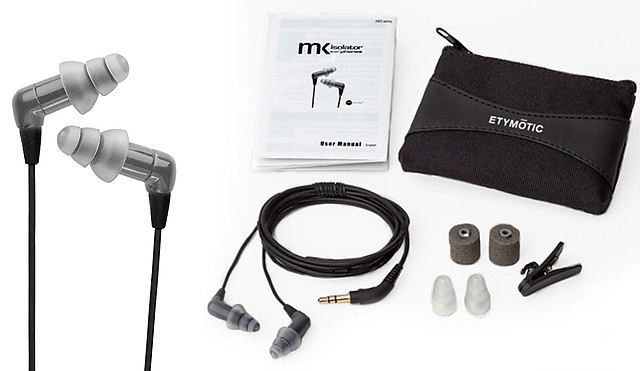
Etymotic’s outstanding, entry level offering – the mk5 Isolator
As to sound, the mk5 Isolator is a less refined version of its older brother, the ER•4 microPro: honest and subjectively flat if a bit restricted at both the low and high end, detailed without being clinical, a touch mid-forward and relatively lacking in microdynamics; resolving power between low amplitude subtleties and the high amplitude bulk of the music. While that may seem like a back-handed complement, it is anything but. For $60, these are great sounding cans, and rugged enough to survive the torture regime of a typical teen.
Next up, the thinksound ms01. A turned wooden body distinguishes this little number. The tapered cylindrical wood, with parallel flats, transitions to an aluminum “baffle” and nozzle. The ms01 shares a notable characteristic with the RHA and UE models: compatibility with Comply™ T Series foam tips, specifically the T-400 size. The 16Ω headphones are supplied with single flange silicon tips in four sizes, along with removable “Active Lifestyle” ear hooks. Because of their small size and fairly symmetrical shape, I found wearing the 01s fine with or without the hooks. The Kevlar-reinforced, 4′ cable terminates in another 45º gold-plated plug along with a natural cotton carrying pouch with draw string, and an all-important spring-loaded lapel clip. The clip is key not so much for hold the cans in place when they’re not in your ears, but for its ability to hold the two sides together without tangles when it’s time to store them away. The product packaging is noteworthy in that it’s virtually plastic-free, composed mostly of paperboard, and is recyclable.
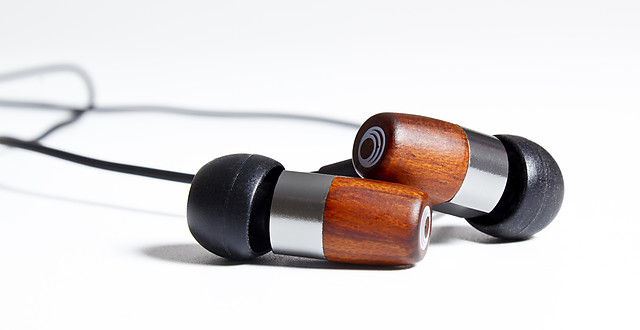
Thinksound’s diminutive, earthy entrant – the ms01
The ms01 is a ported design, said port being a very tiny hole piercing the wooden housing. Aaron Fournier, President of thinksound, said the port limits driver flex at low frequencies. He also mentioned the attention paid to left-right matching. “The maximum deviation between left and right is…between 2dB and 3dB at each frequency and between each channel.” He personally voices each product and also sits on the manufacturing line during a lot of the production. “We do frequency response checking a minimum of 3 times on the production line as well as critical listening.”
The ms01 took about 2 years before he was satisfied with the design. “The nozzle parts we choose and the tolerances we choose are some of the tightest in the industry,” Fournier said. “The (8mm dynamic) drivers themselves also have tuning ports on them…so I can adjust the sound (during the design stage) as we move forward to the final sound in production. The wood housing, the back, is mainly used for the mid to lower frequencies while the (aluminum) front housing really is where the tolerances can change the high frequencies, which is why we choose this combination of materials.”
When listening, I was first struck by the warmth and lower midrange fullness that lends a pleasant roundness without tending toward tubby. A prominent but not excessive low end transitions nicely to good mid to treble balance. The ms01 does not exhibit the mid-range honk often seen in budget cans. With a published frequency response of 18 Hz to 20 kHz (no tolerances) and strong output down to 30 and out past 21k, they have don’t have any perceived high frequency air, but that doesn’t detract from their ability to deliver an engaging sound.
From the turned wood look of the ms01, we go upscale to the stainless sheen of RHA’s entry. Reid Heath’s T10i stands out for its chunky metal look and beefy construction. If Nagra made cans, they might look like a T10. The “i” suffix signifies headset, meaning a 3 button remote and microphone for iOS is in line on the reinforced cable. Three sizes of single flange tips are included, plus two sizes of double flange and memory foam. The T10i nozzles accept the T200 size of Comply tips. A lapel clip is included, as is a no-hassle, padded pleather folio-style carrying case. The 53″ oxygen-free cable terminates in a straight ⅛” gold-plated male plug, one of the few nits I can pick regarding the product design. At the business end, the cables are wrapped with coiled wire before they enter the housing to provide easily user-formable ear hooks. A black plastic sleeve, what I call a keeper, holds the two channels together for storage.
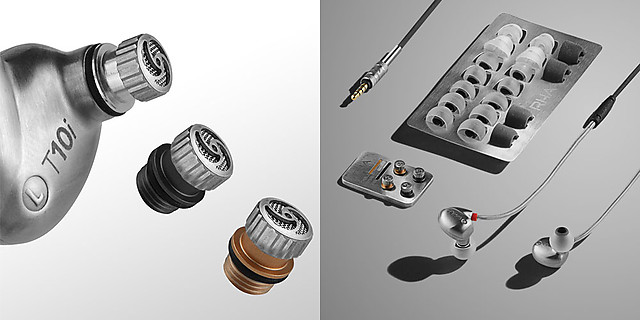
RHAs slick and versatile metal beast – the T10i
What really distinguishes the ported, 16Ω T10 and T10i are a set of acoustic filters that accompany the product. The three threaded filters act as the nozzles, and provide a “reference” response, extra bass, and extra treble. Since these filters can only provide frequency-dependent loss, my guess is that they provide a shelving function, where the TREBLE one shelves down the mid and bass response, while the BASS shelves down the mids and highs.
The published frequency response of the T10 is 16 Hz – 40 kHz ±3dB. With the REFERENCE or TREBLE filters fitted, they are nicely balanced across the audio spectrum, though just a touch “smiley,” with slightly recessed mids. Even in the flat configuration, they exhibit solid low end without sounding warm. No lack there but not accentuated either. In keeping with the higher cost, these RHAs offer much better clarity than my lower cost entrants, with subjectively mo’ betta high end plus lower distortion. Despite the supposed ultrasonic response, the result with the REFERENCE filter is dark and rich. The TREBLE filter adds a welcome touch of texture and is my favorite. I didn’t find the BASS filter to my liking, a bit too rolled off. That said, if you are HF–adverse, it may be just the thing for you. Any way you configure them, you’ll be rewarded with an even–handed and enjoyable listening experience.
During the T10’s development process, over 15 prototypes were 3D printed in Glasgow in order to get it right. All RHA dynamic drivers were developed in-house by their team of designers and engineers to ensure they get the best possible performance from the housing and driver working in collaboration. Ian Smith, RHA’s marketing manager, highlighted the craftsmanship that goes into the production process. “The fact the driver is handmade is highlighted because of the care and attention to detail that is put into producing each one.” The injection molded metal housing is hand finished, resulting in a sexy, brushed metal look.
Housing-wise, the folks at Ultimate Ears chose to let you peak under their qipao, so to speak. With a sealed cerulean see-through case, you can view the guts that make it all work. It’s the IEM equivalent of a skeleton back. In keeping with the cost, the 30Ω UE900s comes with a veritable plethora of accessories and spiffs. First off, the cables: there are two, one a ’phones-only version, while the other has an inline mic and remote for iOS. The cables and housings are connectorized using Molex microminiature MMCX coaxial connectors, so it’s a simple process to swap them out. Both cables terminate in a gold-plated, ⅛” TRS male plug set at 90º. Those 4′ cables are braided, a bit slippery, and include a clear keeper sleeve. The result: a very low tendency to tangle. That tendency is offset by the fairly stiff ear hooks built into the cables. The hooks do so want to intermingle if given the chance. A lapel clip, ⅛” to ¼” gold-plated adapter, drawstring pouch and hard case along with what seems like 18 gazillion single flange and memory foam tips are also part of the package. Actually, there are duplicate tips in six sizes, from 9.5 to 14.5mm which, in combination with the small body size means they’ll fit almost any ear.
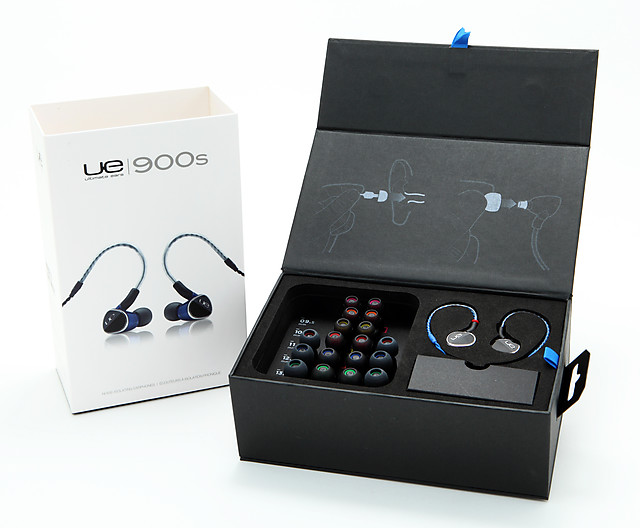
Ultimate Ears’ refined and comfortable UIEM – the UE900s
So, what do you get, sound-wise, for $399? A mildly mid-forward presentation, with a good soundstage and a slight sizzle that enhances the sense of detail. With one of my HRA files, a live recording of the Houston Symphony playing Elgar’s Enigma Variation No. 9 on the High Definition Tape Transfers label, I can clearly hear the 192k analog transfer’s “tape hiss” behind the music in quieter passages. The other cans in this survey simply could not provide that level of detail. Of this crop of cans, the UE900s is arguably the most accurate, and represents an excellent, unbiased value.
I have two complaints with the 900s. One is minor, specifically the size of the hard case. It’s 1.5″ x 2.5″ x 3.5″ and slightly curved along its long axis, perfect for your front pants pocket. Trouble is, getting the ’phones into the case, along with the ¼” adapter, is a fastidious process. A tad more width would have been appreciated. The other issue I had is much more, shall we say, interesting.
Of all the cans discussed so far, only the 900s is a multi-way design. Specifically, a three-way using four balanced armatures; one each for high and mid-frequencies, and two for the bottom. To maintain proper phase alignment, Ultimate Ears uses an unusual design. Rather than mixing all the drivers before sending the result out the nozzle as is the industry norm, the two low frequency transducers are channelled to one outlet while the mids and highs are acoustically summed and directed out their own wide bore. Unlike the mid/HF outlet, the low frequency sound channel is very small, about half the diameter of a straight pin. The two tubes exit at a perpendicular face at the end of the nozzle. In most balanced armature IEM designs, the tiny tubes that lead out of each transducer are summed in a manifold way back in the structure, well away from ear wax and other intrusions. Not so the 900s which, because of their minuscule, easily clogged and very difficult to clean LF outlet, makes the Wax Guard screen built into Comply’s PLUS tips basically mandatory.
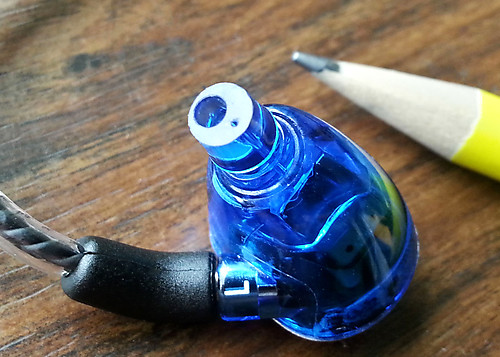
The 900’s very small LF tube next to the larger mid-HF tube
Unlike lower cost, moving coil dynamic drivers in the other products I’ve mentioned, which are basically constructed like miniature spiderless loudspeakers (think tiny tweeters), balanced armature receivers a.k.a. “balanced armatures,” are fundamentally different and, due to their miniature precision, are manufactured by only a handful of companies. How do they work? Imagine a diving board; horizontal when at rest, and easily deflected when a diver steps from the fixed end to the free end. Now, substitute a coil for the diver to provide the energy input, and a fixed magnet for the coil to react to. Adding a signal will cause the diving board or “armature” to flap up and down. To turn that mechanism into a transducer, drill a perpendicular hole into the diving board at the free end, and bolt a thin, stiff rod through that hole. Then, attach the other end of the rod to a taut, rectangular membrane and voilà, an audio transducer. The key design differences between a balanced armatures and your garden variety dynamic headphone driver is that the dynamic driver is driven directly by the attached, cylindrical voice coil while a rod indirectly drives a balanced armatures’s diaphragm via rectangular coils. Balanced armatures are more sensitive than dynamic drivers, and can be very small, allowing for multi–way designs in a compact package.
All of the in-ears I’ve talked about are exemplary for their cost and represent excellent value in their class. The Etymotics are all about truth for listeners of all ages without emptying your wallet, while the thinksounds deliver a plush, romantic rendition of your fave tracks. RHA’s metallic appearance gives little hint of the clean, equitable delivery they afford, while UE’s 900s is an engaging and revealing performer, and a viable entry into the spendy world of high end, custom IEMs.
Manufacturers
Etymotic mk5 Isolator $60
Etymotic Research, Inc.
Elk Grove Village IL 60007 USA
www.etymotic.com
thinksound ms01 $120
Timbre Sound, LLC
Somersworth NH 03878 USA
www.thinksound.com
RHA T10i $200
Reid Heath Ltd.
Glasgow Scotland G3 8TX UK
www.rha-audio.com
Ultimate Ears UE900s $400
Logi Inc. (formerly Logitech)
Newark CA 94560 USA
pro.ultimateears.com
Music in Heavy Rotation During This Review
Belle and Sebastian — Girls in peacetime want to dance (Matador 2014) I am now officially a convert to their hooky Glaswegian pop
The Brand New Opry — Another Time (AIX 2005) Lovely Americana, in high rez and multiple formats
Lucius — Wildewoman (Mom + Pop 2014) Lovely vocals inside catchy compositions, all with atrocious sound quality!
Reggie Quinerly — Invictus (Redefinition Music 2015) Bop that won’t stop, with masterful playing and melodic compositions
Ryan Truesdell — LINES OF COLOR: Gil Evans Project Live at Jazz Standard (2015 Blue Note/ArtistShare) Gil Evans lives again through producer/band leader Truesdell’s deft touch
Twin Danger — Twin Danger (Decca Records 2015) Tasteful production with a realistic soundstage and jazzy, torchy performances; just begging for a significant other and wee dram of single malt…



